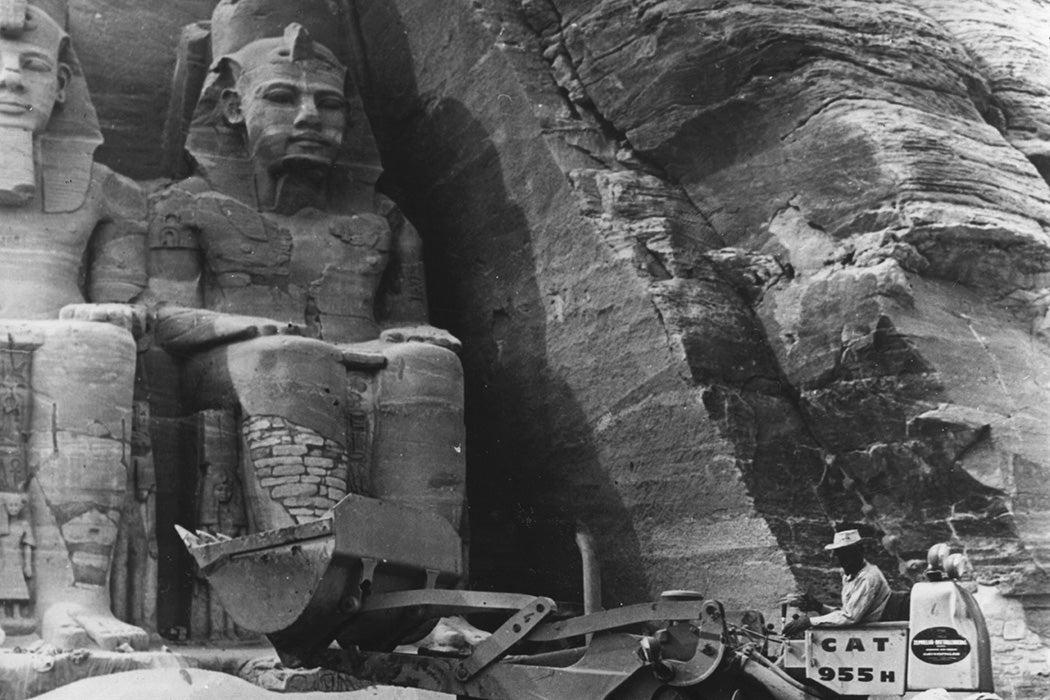The eight 30-to-70-foot-high statues fronting the two temples of Abu Simbel are some of the most iconic remnants of ancient Egypt. For centuries they were buried in desert sand. Sixty years ago, they were in danger of being completely submerged in the rising waters of the dammed Nile.
The Great Temple of Ramesses II and the Small Temple of Hathor and Nefertari were carved out of sandstone more than 3,200 years ago. They are among the most colossal of the antiquities found in Nubia, the region straddling what is now the border between Egypt and Sudan. The area is rich with sites from the New Kingdom, Ptolemaic, and Roman periods. Today these comprise the Nubian Monuments World Heritage Site.
In the 1960s, many of these sites, including Abu Simbel, were threatened with drowning because of the construction of the Aswan High Dam. The resulting reservoir, Lake Nasser, would have put Abu Simbel and other sites underwater if not for an international effort led by United Nations Educational, Scientific and Cultural Organization (UNESCO).

In an epic feat of engineering, Abu Simbel’s statues and temple chambers were disassembled, relocated to higher ground, and then reassembled. More than twenty other sites were also moved during the international Campaign to Save the Monuments of Nubia between 1960 and 1980. Some of these monuments were gifted to other countries, like the Temple of Dendur now at the Metropolitan Museum of Art. Abu Simbel was the most elaborate of the relocations and captured the imagination of many around the world—even as critics assailed the site as a monument to a megalomaniac, representing the “hollow, narcissistic, imperialist power” of a despot.
The Abu Simbel temples were ultimate moved only a couple hundred feet, but to do so the statues had to be cut by hand. Over 7,000 other blocks, weighing from 20 to 30 tons, were also cut and moved. (This 1972 UNESCO documentary details the work with some extraordinary images.) The interior temple spaces were reconstructed under an artificial hill supported by concrete domes.
The feat was akin to something out ancient Egypt, much of it done by hand, only with the support of steel, concrete, trucks, bulldozers, and giant cranes, as well as a new kind of mortar made of Nubian sand and “copious volumes” of plastic epoxy injected into the sandstone to keep it from crumbling.

The project, architectural historian Lucia Allais writes, parallels the pharaonic construction of the Aswan High Dam itself, where some 25,000 workers—including 800 Soviet engineers—labored for a decade to dam the mighty river.
“The temples of Abu Simbel were the largest and most impressive of the [Nubian] temples,” writes Allais, “and they were understood from the start of the project as counter-monuments to the dam. Like the dam, they represented engineering projects of massive scale. Also like the dam, their salvage would require unprecedented international cooperation.”
Allais puts the salvage of Abu Simbel into its geopolitical context, noting that “[d]espite Unesco’s [sic] guarantee of scientific and political neutrality, the overall effect of the temple movement was to optimize the number of tourists to the temples.” Antiquity tourism was then, and remains, vital to the Egyptian economy. But in the eyes of Egypt’s rulers after the 1952 revolution, economic development was the real key to modernity. The great dam at Aswan, which promised electrification and irrigation control, was to be lodestar of the new Egypt. The antiquities would either be lost or moved.
Weekly Newsletter
Allais surveys the international schemes for saving Abu Simbel, characterizing them as “damming, lifting, flooding, floating.” Ultimately chosen was the much cheaper cutting method proposed by a Swedish engineering firm. This was especially appreciated by the United States, a major funder eager for a labor-intensive project because the workforce would be paid in local currency. The US was flush with Egyptian pounds because of the sale of agricultural surplus to Egypt as part of the Food for Peace program. With US–Egyptian relations shaky, getting rid of the Egyptian pounds as soon as possible became the impetus for an ad hoc “monuments-for-peace” program.

“The choice of the cutting scheme was thus a direct result of American foreign policy,” concludes Allais. (US funding was not without controversy at home; with one dimmer Congressman wondering, “Who is Abu Simbel?”)
The relocated Abu Simbel was inaugurated in September 1968.
Abu Simbel’s translation (“translation” literally means “moving the body”) into concrete and plastic modernity took place amid during the birth of the historical/architectural preservation movement. Legal protection for buildings and urban districts were pioneered in France in 1962. The year 1963 saw the unsuccessful effort to prevent the demolition of New York City’s Penn Station. Architects and archeologists from sixteen countries authored the Venice Charter in 1964 calling for the protection of monuments and historic sites. “World heritage” was coined at White House conference in 1965 that argued for the preservation of the “cultural diversity of the earth.” The US’s National Historic Preservation Act was passed in 1966. UNESCO’s World Heritage Convention in 1972 created the World Heritage system, to which Abu Simbel and surroundings were added in 1979.







